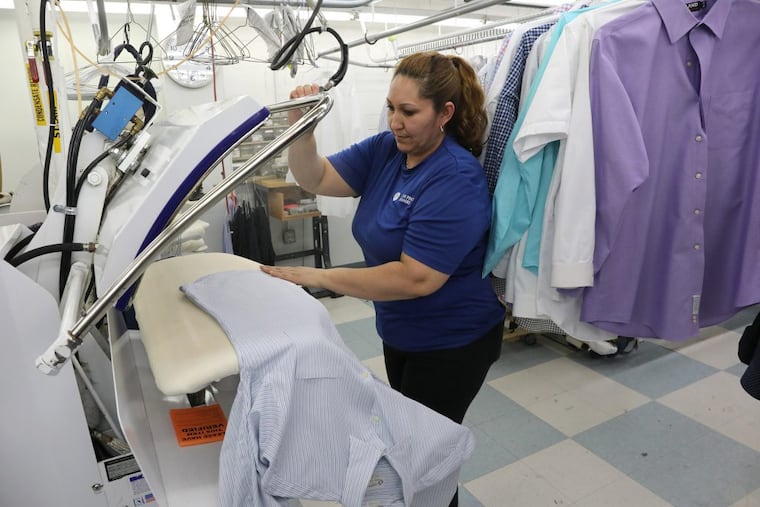What dry cleaning should cost and how to find good shops around Philly
Many area dry cleaners were rated "superior" overall by 90 percent of surveyed customers. But some shops got favorable ratings from fewer than 60 percent of clients. Here's what items should cost.

You look and feel great wearing your favorite clothes, but spills, stains, and just plain stinkyness can keep you from rocking them. You need a dry cleaner you can trust — a star with stain solutions, a pro at pressing, and a wiz with whitening agents.
Nonprofit consumer group Delaware Valley Consumers' Checkbook ratings of nearly 200 area dry cleaners for quality and price can help you identify what businesses will do a great job cleaning your wardrobe — without cleaning out your wallet. Until Aug. 10, Checkbook is offering free access to its ratings of area dry cleaners to Philadelphia Inquirer and Philly.com readers through this link: Checkbook.org/inquirer/drycleaners.
Many of the dry cleaners Checkbook evaluated were rated "superior" overall by 90 percent or more of their surveyed customers. But some shops received such favorable ratings from fewer than 60 percent.
Here are key questions to make your own quality checks:
· When you drop off garments, do clerks thoroughly ask about stains and note information you provide?
· Do staffers provide coherent answers to your questions about whether a difficult stain will come out?
· Are your clothes ready when promised?
· Do the garments look and smell clean?
· Were the clothes pressed properly? One of the most common complaints Checkbook receives from dry cleaning customers is that shops press garments sloppily, leaving "double creases" and crushing or losing buttons.
· Does the dry cleaner have an efficient system for finding your garments when you pick them up?
Although you want good work, you don't want to get taken to the cleaners financially. Checkbook's evaluations include prices, which were calculated based on numbers quoted to our undercover shoppers who checked each shop's costs to clean 12 items.
Checkbook's shoppers found huge shop-to-shop price variations:
· Dry cleaning a women's cashmere overcoat ranged from $1.99 to $30.
· A men's two-piece wool suit could be between $3.90 and $25.
· A women's silk blouse cost from $1.95 to $16.50.
· A men's cotton dress shirt ran customers anywhere from $0.99 to $5.30.
You don't have to overpay to get high-quality work. Checkbook found no correlation between price and customer satisfaction. Shops that charge low prices are just as likely to do great work as shops that charge high prices.
Besides using a low-cost company, you can save money by cleaning many garments yourself.
Start by closely reading the care label. Most manufacturers are required to list only one way to clean a garment. If the tag reads "dry clean only," respect that as sartorial gospel. If it says "dry clean," that's the recommended method, but you might be able to clean it yourself. But don't try to wash materials that spot or shrink in water. That includes silk, acetate, velvet, taffeta, and many wool items. But you usually can hand wash or machine wash cashmere, linen, cotton, and polyester. If a garment has a lining or trim, pay special attention to care instructions. While a tweed exterior is probably good for hand washing, its nylon lining might not be.
Before taking your clothes to be cleaned, check them for stains and empty all the pockets. Point out stains to the clerk and provide as much information about them as possible. The more the spotter knows about what caused a stain, how long it's been there, and what, if anything, you've used to treat it, the better the chances of removing it. Also indicate any hidden spots — particularly sugary spills (soft drinks, white wine, fruit juice). Pin a tag or have a staffer put tape on each stain to ensure that the spot comes out.
If there's a problem you believe the dry cleaner caused, ask to have the work redone; a reputable shop will be happy to redo it for free. If the shop admits an error that permanently damaged your garment, the shop should give you the price of the garment and waive cleaning charges.
Unfortunately, you can't count on getting the replacement cost for your favorite jacket. According to the widely used "Fair Claims Guide" published by the Drycleaning and Laundry Institute, a dry cleaner should cover the replacement cost of the garment only after adjustment for its condition and based on the unused portion of its life expectancy —two years for a tie or three years for a women's blouse.